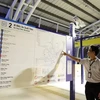Half a century after the US army sprayed Agent Orange-laced herbicides over Vietnam, millions of people in the country have been forced to deal with the deadly diseases caused by this toxic chemical.
According to the Vietnam Association of Victims of Agent Orange /dioxin (VAVA), between 1961 and 1971, US troops sprayed 80 million litres of herbicides over the South Vietnam battlefields, including nearly 400 kg of dioxin – one of the most highly toxic chemicals. This was considered the largest and longest-running chemical war, with the most terrible consequences in the history of humankind.
Up to 4.8 million Vietnamese people were exposed to AO/dioxin, with 3 million now suffering health problems. In some hotspots in Vietnam , dioxin residues in the environment, animals and humans exceeded the permitted level of the US Environmental Protection Agency by hundreds of times.
Research by Vietnamese and foreign scientists affirmed the rate of disease contracting among descendants of exposed people, especially cancers and reproductive disorders, and congenital malformations is much higher than those who are not exposed to this toxic chemical.
In past years, the Vietnamese Government had issued and actively implemented various policies and programmes in support of AO victims, including monthly allowances for over 200,000 victims and support for some non-governmental organisations, including VAVA and the Fund for AO/dioxin Victims, to provide health care, vocational training and employment for more than 1 million others.
Thousands of AO victims, especially children with congenital malformations, have been cared for, brought up and provided with medical treatment in Hoa Binh and Huu Nghi Villages and children’s centres nationwide.
In addition, Vietnam has received support from many international organisations, such as the UN Development Programme, UN Children’s Fund, Ford Fund, the Vietnam Veterans of American Foundation (VVAF), the Vietnam Agent Orange Relief & Responsibility Campaign (VAORRC) and France’s organisation for dioxin children as well as many individuals from Japan, Germany, Norway, the UK and the US.
Illogically, the US government has spent billions of USD each year supporting war veterans who had fought in Vietnam and are suffering AO-related diseases, but did not admit responsibility for millions of Vietnamese AO victims.
Therefore, in 2004, VAVA submitted petitions to US courts of all levels to proceed against 37 chemical companies which had produced and provided chemicals for the US troops during the war in Vietnam .
Vietnamese AO victims’ lawsuit for justice, represented by VAVA, won international support, with struggles taking place in many countries, including the US.
In May 2009, the International People’s Tribunal of Conscience held by the International Association of Democratic Lawyers issued a verdict requesting the US to compensate Vietnamese AO victims and detoxify dioxin-contaminated areas in Vietnam.
However, the US only provided Vietnam with 24 million USD in the 2007-2010 period and 34 million USD in 2010 for projects to improve the environment and support the disabled./.
According to the Vietnam Association of Victims of Agent Orange /dioxin (VAVA), between 1961 and 1971, US troops sprayed 80 million litres of herbicides over the South Vietnam battlefields, including nearly 400 kg of dioxin – one of the most highly toxic chemicals. This was considered the largest and longest-running chemical war, with the most terrible consequences in the history of humankind.
Up to 4.8 million Vietnamese people were exposed to AO/dioxin, with 3 million now suffering health problems. In some hotspots in Vietnam , dioxin residues in the environment, animals and humans exceeded the permitted level of the US Environmental Protection Agency by hundreds of times.
Research by Vietnamese and foreign scientists affirmed the rate of disease contracting among descendants of exposed people, especially cancers and reproductive disorders, and congenital malformations is much higher than those who are not exposed to this toxic chemical.
In past years, the Vietnamese Government had issued and actively implemented various policies and programmes in support of AO victims, including monthly allowances for over 200,000 victims and support for some non-governmental organisations, including VAVA and the Fund for AO/dioxin Victims, to provide health care, vocational training and employment for more than 1 million others.
Thousands of AO victims, especially children with congenital malformations, have been cared for, brought up and provided with medical treatment in Hoa Binh and Huu Nghi Villages and children’s centres nationwide.
In addition, Vietnam has received support from many international organisations, such as the UN Development Programme, UN Children’s Fund, Ford Fund, the Vietnam Veterans of American Foundation (VVAF), the Vietnam Agent Orange Relief & Responsibility Campaign (VAORRC) and France’s organisation for dioxin children as well as many individuals from Japan, Germany, Norway, the UK and the US.
Illogically, the US government has spent billions of USD each year supporting war veterans who had fought in Vietnam and are suffering AO-related diseases, but did not admit responsibility for millions of Vietnamese AO victims.
Therefore, in 2004, VAVA submitted petitions to US courts of all levels to proceed against 37 chemical companies which had produced and provided chemicals for the US troops during the war in Vietnam .
Vietnamese AO victims’ lawsuit for justice, represented by VAVA, won international support, with struggles taking place in many countries, including the US.
In May 2009, the International People’s Tribunal of Conscience held by the International Association of Democratic Lawyers issued a verdict requesting the US to compensate Vietnamese AO victims and detoxify dioxin-contaminated areas in Vietnam.
However, the US only provided Vietnam with 24 million USD in the 2007-2010 period and 34 million USD in 2010 for projects to improve the environment and support the disabled./.



















